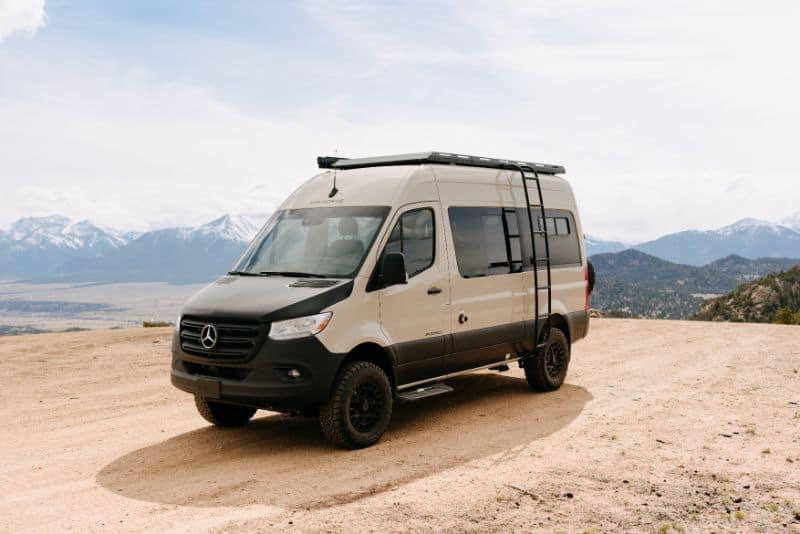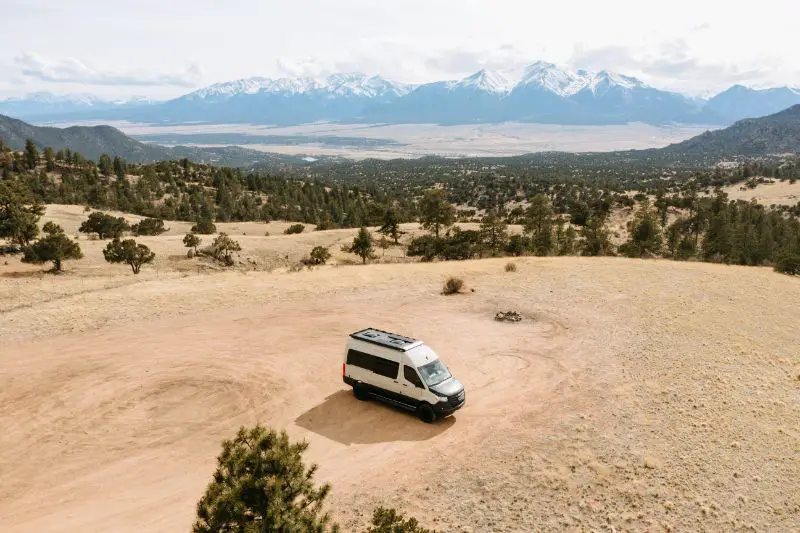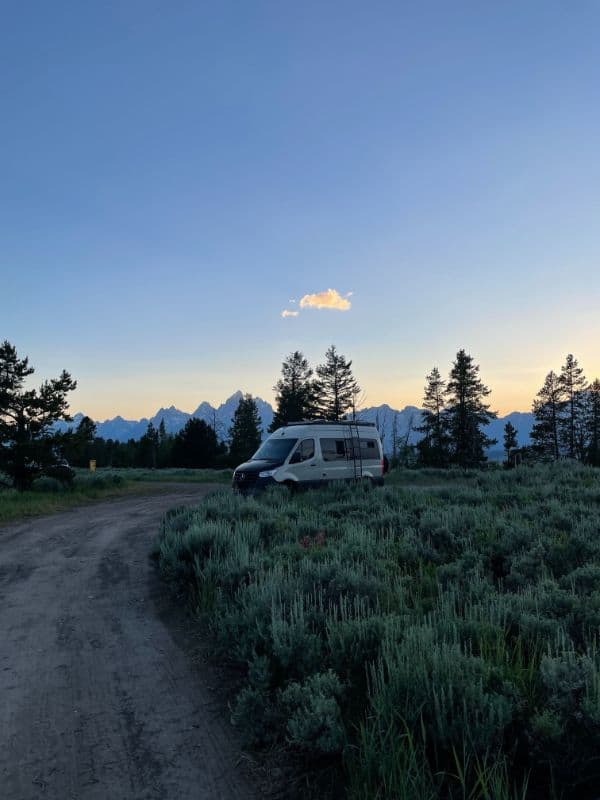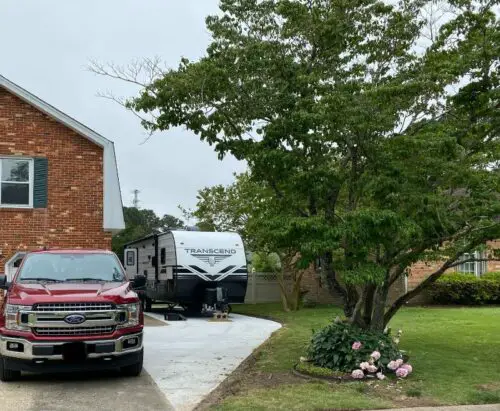
Between the epic landscapes, stunning views of sunrises and sunsets, and the crisp air, camping at a high elevation is undoubtedly rewarding. According to the National Library of Medicine, high altitude is considered land at least 4,900 feet above sea level.
For six years, my husband and I have called Colorado home. Although we spent some of those years living in an apartment and tent camping on the weekends, we also consider it our home base for van life. We have camped around the state in numerous high-elevation campsites, including some at elevations as high as 11,500 feet. Since our van does not have air conditioning, we especially love camping at a higher elevation in the summer due to the cooler air.
For some, this idea of camping at a high elevation is a bit scary, as there are different factors to consider compared to camping at a lower elevation. However, if you take the time to educate and prepare yourself, I truly believe that all nomads can reap the benefits of camping at a high altitude. Here are eight essential tips to help you feel comfortable and confident while camping at a high elevation.
Prepare for petulant weather
Anyone who has spent time in mountainous areas knows the weather can change without warning. A morning that begins with sunshine and clear skies can quickly transition into an afternoon with dangerous thunderstorms. We have even seen random snowstorms while driving over mountain passes in June.
While I highly recommend checking multiple sources for the weather forecast, even this is unreliable. Weather patterns at high elevations can change rapidly and unexpectedly.
As a result, you should prepare for all weather. Ensure your rain jackets, umbrellas, gloves, and hats are easily accessible in your van or RV. If you set up furniture outside, plan to put everything away quickly if needed. I also recommend having an ice scraper in your vehicle should you need to clear off windows. Many grocery stores and hardware stores in mountainous areas carry them.
Depending on the conditions, you may need to abandon your campsite, as discussed in tip number 5. I encourage you to do this to protect yourself from harsh conditions and your rig from any damage.
Hydrate & plan for extra cooking time

Stay hydrated outside, especially at a high elevation. However, too much extra water is unnecessary and will not protect you from altitude illness. According to the High Altitude Doctor, “You only need an additional liter to a liter and a half of water at altitude. Too much water is harmful and can dilute your body’s sodium level (hyponatremia) causing weakness, confusion, seizures, and coma.” Due to the risk of experiencing these adverse effects, be careful not to over-hydrate.
How do you know if you are sufficiently hydrated? The High Altitude Doctor recommends checking the color of your urine. If your urine is dark, you need to drink more water. If your urine is clear, you are also in the clear!
>>> READ MORE: How to Make Coffee While Van Camping (Without Fire)
Nourish your body while camping at a high elevation. Continue to eat meals throughout the day to maintain high energy levels. Also, expect to spend a bit longer cooking your food. According to the U.S. Department of Agriculture Food Safety and Inspection Service (USDA), the boiling point of water gets lower as altitude increases due to the decrease in atmospheric pressure. The USDA explains, “Because water boils at a lower temperature at higher elevations, foods that are prepared by boiling or simmering will cook at a lower temperature, and it will take longer to cook.” The USDA recommends using a food thermometer to ensure food is at a safe internal temperature.
Know the signs of altitude illness
According to the Centers for Disease Control and Prevention (CDC), low oxygen levels in the air can result in altitude illness. Altitude illness can occur from traveling to high elevations too quickly. It can also happen from drinking too much alcohol or exercising too heavily within the first 48 hours.
The CDC states that the mildest form of altitude illness is acute mountain sickness (AMS). Symptoms of AMS include headache, tiredness, lack of appetite, nausea, and vomiting. For children who cannot yet speak, they may appear fussy. In intense forms of altitude illness, symptoms may include extreme fatigue, drowsiness, confusion, loss of coordination, shortness of breath, weakness, or cough.
My husband and I have experienced headaches due to altitude illness. In accordance with CDC guidelines, we typically take a pain reliever such as Advil, and the headache disappears within a couple of hours. It may return within our first couple of days at a high elevation.
However, if your symptoms worsen, the CDC recommends descending to a lower elevation quickly to prevent extreme illness or death. Depending on the severity, you may need treatment with oxygen.
Use sun protection
It is easy to forget that when you ascend to a high elevation, you become closer to the sun. As a result, it is easy to become sunburnt and expose yourself to damaging UV rays if you do not take precautions.
According to Kelowna Skin Cancer Clinic, for every 1,000 feet of elevation gained, there is an increase of 6-10% UV exposure. These UV rays can make your skin thin, wrinkled, hyper-pigmented, and cause skin cancer.

To avoid these harmful effects and painful sunburn, I recommend using sun protection to keep yourself covered. Apply sunscreen regularly with at least 35 SPF. Wear a sun hat and clothing that protects your skin. I tend to wear lightweight long-sleeve shirts, pants, and a Buff around my neck. You may also want to purchase some sunglasses to protect your vision.
Make a Plan B (and C)
Due to a change of weather, sudden sickness, or some other unforeseen circumstance, you may need to change plans quickly and abandon your high-elevation campsite. In my experience, it is often better to be safe and leave than risk trying to stay.
Prepare options for other low-elevation spots. You will then have places to go if leaving is the best course of action. Due to a lack of reliable cell phone service, you should know how to get to these spots using a map or have directions downloaded onto your device in advance.
I recommend preparing multiple options in case areas are full or closed. We have been in situations where we had to improvise a plan C. If you have multiple backup options, you will save yourself from experiencing panic or stress should you need to move.
Check Tire Pressure

As you gain feet in elevation when driving from a lower elevation to a higher one, your tires will experience a slight gain in pressure, usually 2-3 PSI. According to RV Magazine, this happens because as elevation increases, atmospheric pressure decreases.
However, gaining (or losing upon descending) 2-3 PSI is no cause for concern. It will not hurt your van or RV. When you arrive at your destination, give your vehicle some time to cool down before checking the tire pressure. If it has increased or decreased more than 2-3 PSI, then adjust as needed.
Monitor Your Fuel & Engine
Your engine may be a bit more sluggish at a higher altitude. Camper Report states that “for every 3,000 feet you gain in altitude, your engine can lose about 10 percent of its rated output.” While this can affect all class A, B, and C RVs, gas engines will struggle more than diesel engines.
For this reason, it is important to ensure you have plenty of fuel before ascending to a remote, dispersed camping spot on top of a mountain. Make sure you plan ahead to fuel your RV or van.

The roads to get to higher-elevation campsites are inherently more difficult for your vehicle to climb. There are often steep grades and sharp turns that you will need to maneuver your vehicle through. This puts more strain on your engine, which could lead to overheating or an engine fire if not monitored closely. Have a fire extinguisher with you for a worst-case scenario.
>>> READ MORE: 21 Motorhome Maintenance Tips for Beginners
Equip Yourself with Efficient Appliances
Appliances are not as dependable at elevations over 6,000 feet. According to Camper Report, “Due to the lower oxygen density, they will have a more difficult time running and will run less efficiently.” If you plan to camp at a high elevation for an extended time, you can use a high-altitude kit with your generator.
You may need to switch over to battery power or 110 if you have a 3-way fridge. The lower atmospheric pressure may result in your fridge losing power.
Keep an eye on the temperatures in terms of your water lines and tanks. If it gets down into the 30s at night, you could risk waking up to pipes that have cracked. I have a diesel heater that I run at night to help prevent this.
Conclusion
Although camping at a high elevation takes some extra preparation, it is worth the time spent planning to appreciate the unbeatable views and experiences that come with it. Remember, most people do not have a life-threatening emergency when camping at a high elevation. However, it is crucial to equip yourself with the knowledge and tools to know what to do if something happens.
If you keep these eight essential tips in mind during your high-elevation camping trip, you can get to your campsite, enjoy the mountain air, and live fully in the moment with peace of mind!
Guest author for Changing Gears. Kaylin is a skilled writer, avid traveler, seasoned camper and road warrior, and a skilled brand coordinator.
-
Kaylin Zittergruenhttps://changingears.com/author/kaylin-zittergruen/








